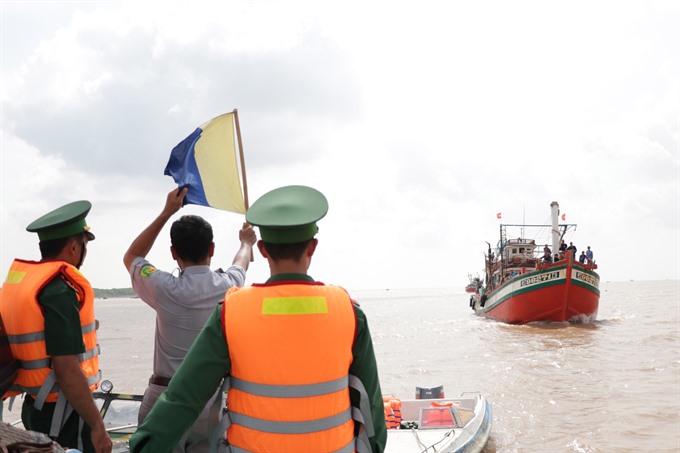 Society
Society

The Mekong Delta province of Bến Tre has sustainably developed both aquaculture and offshore fishing in the last 10 years under a national marine strategy.
 |
| Bến Tre Province officials monitor fishing vessels at the mouth of the Hàm Luông River in Ba Tri District. — VNA/VNS Photo Huỳnh Phúc Hậu |
HCM CITY — The Mekong Delta province of Bến Tre has sustainably developed both aquaculture and offshore fishing in the past 10 years under a national marine strategy.
Nguyễn Văn Buội, deputy director of the provincial Department of Agriculture and Rural Development, said with its long coast, the province has favourable conditions for developing both.
It has a total of 46,500ha of aquaculture ponds with an annual output of 265,000 tonnes in the coastal districts of Ba Tri, Bình Đại and Thạnh Phú, accounting for 44.6 per cent of the province’s total fisheries output, he said.
It has developed logistics and the processing industry to add value to its fishing and aquaculture products, he said.
After 10 years of implementing the marine strategy, the province has installed infrastructure for aquaculture like irrigation systems, roads and electricity supply in the three coastal districts.
They each have a fishing port that can handle 150 boats a day.
The one in Bình Đại District port has the capacity to handle 40,000 tonnes of fish and other aquatic species a year.
The province has also built storm shelters for fishing boats, with the one in Bình Đại capable of accommodating more than 1,000 of them.
There are 11 processing plants in the province with a total annual capacity of 72,000 tonnes of seafood for exports.
With its 60km of coast, many alluvial grounds and islets, the province’s marine economy has enormous potential.
It has used technology to develop the fishery sector and protect aquatic resources in coastal areas.
Many farmers and companies have adopted advanced farming techniques like Vietnamese and global good agricultural practices and Marine Stewardship Council (SMC) standards in aquaculture.
Most clam co-operatives in the province, for instance, have adopted SMC standards.
Lê Văn Quang, deputy director of the Rạng Đông Seafood Co-operative in Bình Đại District, said breeding clams following SMC standards requires protecting the environment and baby clams. Thus, the co-operative only harvests 70-80 per cent of available claims in its breeding ground to ensure the regeneration of the natural clam population, he said.
The province has more than 7,100ha of clam farms, according to its Aquaculture Sub-department.
Farmers in the province also breed shrimp on around 11,500ha, mostly white-legged shrimp and black-tiger shrimp.
Võ Văn Lân, who has farmed shrimp for 20 years in Thạnh Phú District’s Mỹ An Commune, said: “There is no farming model that provides higher profits than shrimp breeding.”
He has 2ha and intensive farming fetches him an average income of VNĐ200 million (US$8,570) per crop, he said.
With the development of the marine economy, the life of people in the three coastal districts have improved and they have access to healthcare, education and other basic social security needs.
The province has provided soft loans for fishermen to upgrade or build new boats with higher capacity.
The province has increased the number of its fishing boats from 969 in 2007 to more than 3,900 now. They include 2,000 vessels that can fish off-shore.
Last month, the province signed an agreement with the delta’s Tiền Giang, Trà Vinh, Sóc Trăng, Bạc Liêu, Kiên Giang and Trà Vinh provinces and the south-central province of Bình Thuận to monitor fishing boats to ensure they comply with legal provisions. — VNS




